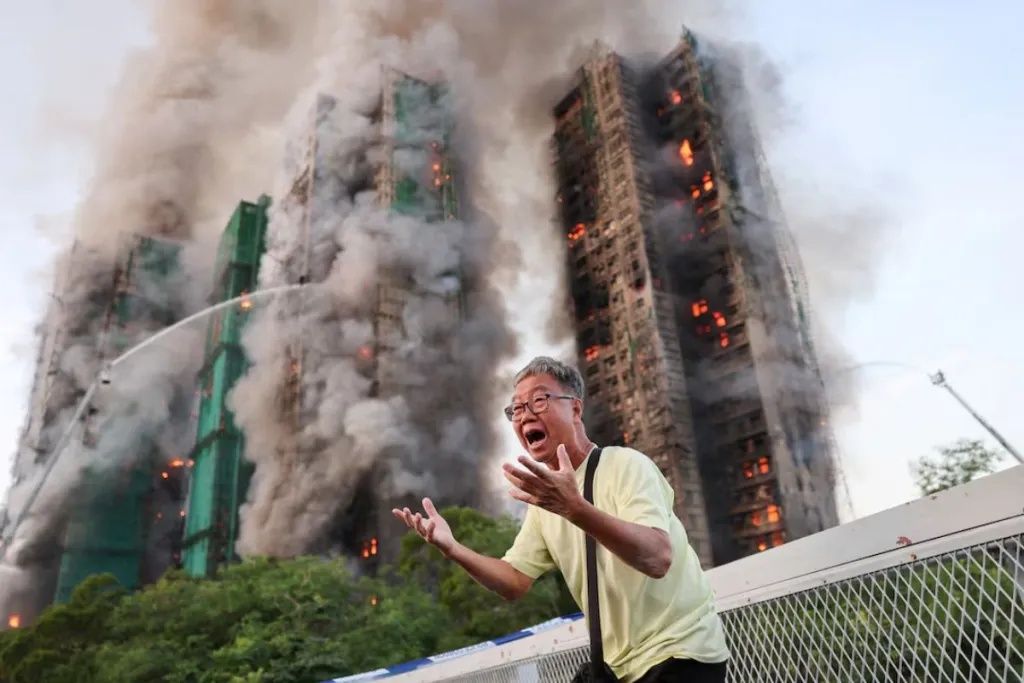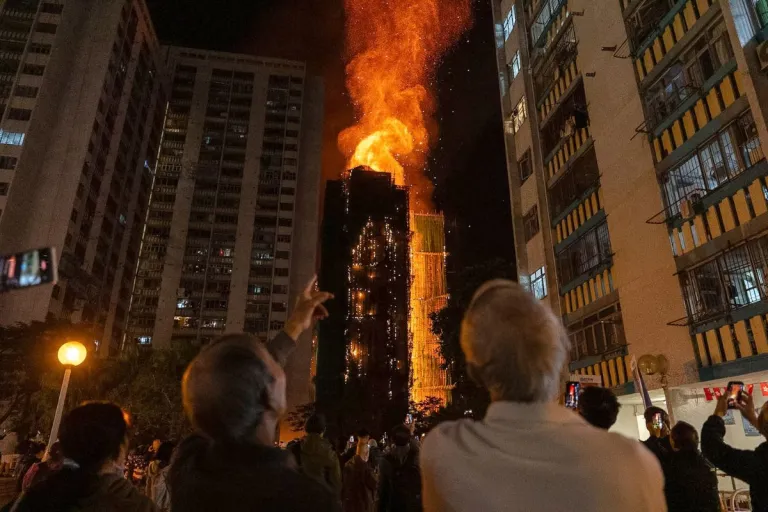Halal, tasty, and affordable!
Hong Kong Apartment Fire Disaster: Wang Fuk Court Tragedy Claims 44 Lives, 279 Missing

On 26 Nov 2025, just before 3:00 pm local time, a major fire broke out at Wang Fuk Court, a public‑housing estate in Tai Po, Hong Kong. The complex, built in the 1980s, consists of eight 31‑storey blocks, with around 1,984 flats housing roughly 4,800 residents.
At the time of the fire, all towers were undergoing renovation and wrapped in bamboo scaffolding and green safety mesh, a common but traditional method for external refurbishment in Hong Kong.
Residents and onlookers described a horrifying scene: thick black smoke billowing into the sky, flames climbing rapidly up the scaffolding, and many people trapped inside as corridors, stairwells, and lift lobbies filled with smoke within minutes.
How the Fire Spread So Quickly

Image credit: Yan Zha | Getty Images
Investigations and official statements indicate that the fire likely started externally on the bamboo scaffolding or protective netting. Once ignited, the flames spread up the outside of one building and cascaded to nearby towers, a rapid spread aided by combustible materials used during renovation.
Authorities reported finding styrofoam (or foam insulation) material inside some flats, placed near windows and lift‑lobby areas. That, combined with wind conditions and the bamboo + mesh exterior, reportedly helped the fire engulf multiple blocks within minutes.
Fire services described the fire’s progression as “unusually fast”, faster than would be expected under standard fire‑safety conditions, raising serious questions about the materials and compliance with building regulations.
Human Toll: Dead, Injured, Missing

Image credit: Tyrone Siu | Reuters
By early morning on 27 Nov 2025, Hong Kong authorities had confirmed a death toll of at least 44 people, including a firefighter. At the same time, 279 people remained unaccounted for (missing). Hospital reports indicated dozens of injuries, many in serious or critical condition; some sources mention 45 people hospitalised in critical condition.
Residents and their families have described terrifying scenes: smoke-filled hallways, overloaded evacuation routes, confusion, and desperation as loved ones disappeared or remained uncontactable. Many displaced survivors have been moved to emergency shelters for safety and support.
Emergency Response & Evacuation

Image credit: Chan Long Hei | AP
Once the fire was reported at around 2:51 pm, the situation escalated quickly. By 3:34 pm, the fire had reached alarm level 4, and by 6:22 pm, it was raised to No. 5 alarm, the highest emergency classification in Hong Kong’s fire‑response system.
The scale of response was massive: nearly 800 firefighters, supported by 128 fire engines, were dispatched to the scene.
Evacuation efforts and temporary shelters were swiftly set up. Around 900 to 1,000 residents were relocated to community centres and other safe venues after being displaced.
The blaze took many hours to bring under partial control. By late night into early morning, firefighters had managed to extinguish the fire in several blocks, but some buildings remained unstable and smoke persisted, complicating search and rescue operations.
Investigation, Arrests & Accountability

Image credit: Chan Long Hei | AP
In the early hours after the fire, police arrested three men who are identified as two directors of the renovation contractor and an engineering consultant, on suspicion of manslaughter and gross negligence, citing possible use of non‑compliant scaffolding materials, neglect of fire‑safety protocols, and unsafe renovation practices.
Authorities confirmed that the use of flammable foam insulation, possibly in windows and lift‑lobby areas, contributed to the rapid internal spread of the fire. Investigators say they will conduct a thorough audit of renovation practices and material compliance, particularly at other older public housing estates that still use bamboo scaffolding.
Hong Kong’s leadership has pledged “full accountability,” and families of victims have called for stringent reforms in building and renovation safety standards.
Community Impact & Victims Stories

Image credit: Tyrone Siu | Reuters
For many residents of Tai Po, the fire has been a life‑shattering catastrophe. Families have lost loved ones or remain anxiously waiting for news of missing relatives. Survivors speak of panic, chaos, and trauma corridors choked with smoke, collapsed scaffolding, falling embers, and windows aflame.
Elderly residents, in particular, reported being unable to descend smoky stairwells fast enough; some were trapped as lift systems failed. Others have expressed despair at watching their homes, personal belongings, and years of memories go up in smoke.
Emergency shelters are now filled with displaced families, many having lost everything. NGOs and volunteers are providing immediate aid, including food, blankets, and medical attention, but the emotional and psychological toll runs deep.
This tragedy has also sparked sharp public outrage. Many local and international groups are calling for a major overhaul of building‑safety regulations and tighter oversight over renovation and construction practices in Hong Kong’s dense, high‑rise housing landscape.
Why This Tragedy Matters
The fire at Wang Fuk Court is now the deadliest residential blaze Hong Kong has experienced in decades. It starkly highlights how traditional construction methods like bamboo scaffolding, combined with inadequate safety oversight and non‑fire‑resistant materials, can become a lethal mix in dense urban high‑rises.
The scale of destruction, loss of life, and displacement underscores the urgent need for reform: stricter building-material standards, rigorous enforcement, transparent renovation practices, and regular audits of old housing estates.
Published at
About Author
Aimi Zulkiflee
Subscribe our Newsletter
Get our weekly tips and travel news!
Recommended Articles
Latest Articles
8 Best Halal Hainanese Chicken Rice Spots in Singapore for Budget Travelers Beast Land Riyadh 2025: MrBeast’s Theme Park Opens With Rides, Challenges & Muslim-Friendly Tips Experience the exclusive MrBeast’s theme park from 13 Nov to 27 Dec 2025!
11 Must-See Winter Illuminations in Osaka 2025–2026 for Muslim Travellers Experience winter in Osaka with lights, snow & festive fun
What Travellers Need to Know About Indonesia's Mount Semeru Eruption Mount Semeru’s status raised to alert level
What I Learned About Hong Kong While Travelling as a Muslim Oh come on, HK isn't just about Disneyland!

